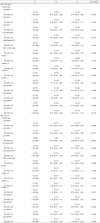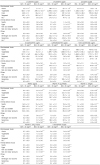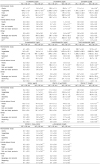1. Williams EP, Mesidor M, Winters K, Dubbert PM, Wyatt SB. Overweight and obesity: prevalence, consequences, and causes of a growing public health problem. Curr Obes Rep. 2015; 4(3):363–370.

2. Global BMI, Di Angelantonio E, Bhupathiraju SN, Wormser D, Gao P, Kaptoge S, Berrington de, Cairns BJ, Huxley R, Jackson CL, Joshy G, Lewington S, Manson JE, Murphy N, Patel AV, Samet JM, Woodward M, Zheng W, Zhou M, Bansal N, Barricarte A, Carter B, Cerhan JR, Smith GD, Fang X, Franco OH, Green J, Halsey J, Hildebrand JS, Jung KJ, Korda RJ, McLerran DF, Moore SC, O'Keeffe LM, Paige E, Ramond A, Reeves GK, Rolland B, Sacerdote C, Sattar N, Sofianopoulou E, Stevens J, Thun M, Ueshima H, Yang L, Yun YD, Willeit P, Banks E, Beral V, Chen Z, Gapstur SM, Gunter MJ, Hartge P, Jee SH, Lam TH, Peto R, Potter JD, Willett WC, Thompson SG, Danesh J, Hu FB. Body-mass index and all-cause mortality: individual-participant-data meta-analysis of 239 prospective studies in four continents. Lancet. 2016; 388(10046):776–786.
3. Korea Centers for Disease Control and Prevention. Korea health statistics 2016: Korea National Health and Nutrition Examination Survey (KNHANES VII-1) [Internet]. Cheongju: Korea Centers for Disease Control and Prevention;2017. cited 2018 Aug 22. Available from:
https://knhanes.cdc.go.kr/knhanes/sub04/sub04_03.do?classType=7.
4. Lizcano F, Guzmán G. Estrogen deficiency and the origin of obesity during menopause. BioMed Res Int. 2014; 2014:757461.

5. Ryan DH, Braverman-Panza J. Obesity in women. J Fam Pract. 2014; 63:2 Suppl. S15–S20.
6. Dinh QN, Drummond GR, Sobey CG, Chrissobolis S. Roles of inflammation, oxidative stress, and vascular dysfunction in hypertension. BioMed Res Int. 2014; 2014:406960.

7. Bondia-Pons I, Ryan L, Martinez JA. Oxidative stress and inflammation interactions in human obesity. J Physiol Biochem. 2012; 68(4):701–711.

8. Mangge H, Summers K, Almer G, Prassl R, Weghuber D, Schnedl W, Fuchs D. Antioxidant food supplements and obesity-related inflammation. Curr Med Chem. 2013; 20(18):2330–2337.

9. Zavala G, Long KZ, García OP, Caamaño MC, Aguilar T, Salgado LM, Rosado JL. Specific micronutrient concentrations are associated with inflammatory cytokines in a rural population of Mexican women with a high prevalence of obesity. Br J Nutr. 2013; 109(4):686–694.

10. Palace VP, Khaper N, Qin Q, Singal PK. Antioxidant potentials of vitamin A and carotenoids and their relevance to heart disease. Free Radic Biol Med. 1999; 26(5-6):746–761.

11. Garcia-Diaz DF, Lopez-Legarrea P, Quintero P, Martinez JA. Vitamin C in the treatment and/or prevention of obesity. J Nutr Sci Vitaminol (Tokyo). 2014; 60(6):367–379.

12. Jiang Q. Natural forms of vitamin E: metabolism, antioxidant, and anti-inflammatory activities and their role in disease prevention and therapy. Free Radic Biol Med. 2014; 72:76–90.

13. Botella-Carretero JI, Balsa JA, Vázquez C, Peromingo R, Díaz-Enriquez M, Escobar-Morreale HF. Retinol and alpha-tocopherol in morbid obesity and nonalcoholic fatty liver disease. Obes Surg. 2010; 20(1):69–76.
14. Wang L, Gaziano JM, Norkus EP, Buring JE, Sesso HD. Associations of plasma carotenoids with risk factors and biomarkers related to cardiovascular disease in middle-aged and older women. Am J Clin Nutr. 2008; 88(3):747–754.

15. Wilson R, Willis J, Gearry R, Skidmore P, Fleming E, Frampton C, Carr A. Inadequate vitamin C status in prediabetes and type 2 diabetes mellitus: associations with glycaemic control, obesity, and smoking. Nutrients. 2017; 9(9):E997.

16. Ministry of Health and Welfare, The Korean Nutrition Society. Dietary reference intakes for Koreans 2015. Sejong: 2015.
17. Rural Development Administration (KR). Food composition table. 8th revision. Suwon: Rural Development Administration;2011.
18. Rural Development Administration (KR). Tables of food functional composition. Suwon: Rural Development Administration;2009.
19. United States Department of Agriculture, Agricultural Research Service. USDA national nutrient database for standard reference, release 28. Washington, D.C.: United States Department of Agriculture;2016.
20. Ministry of Education, Culture, Sports, Science and Technology (JP). Standard tables of food composition in Japan. Tokyo: Ministry of Education, Culture, Sports, Science and Technology;2010.
21. Jun S, Chun OK, Joung H. Estimation of dietary total antioxidant capacity of Korean adults. Eur J Nutr. 2018; 57(4):1615–1625.

22. Chun OK, Chung SJ, Song WO. Estimated dietary flavonoid intake and major food sources of U.S. adults. J Nutr. 2007; 137(5):1244–1252.
23. Ahn S, Jun S, Kim SA, Ha K, Joung H. Current status and trends in estimated intakes and major food groups of vitamin E among Korean adults: using the 1~6th Korea National Health and Nutrition Examination Survey. J Nutr Health. 2017; 50(5):483–493.
24. Kim SA, Jun S, Joung H. Estimated dietary intake of vitamin A in Korean adults: based on the Korea National Health and Nutrition Examination Survey 2007~2012. J Nutr Health. 2016; 49(4):258–268.

26. National Research Council (US). Recommended dietary allowances. 10th edition. Washington, D.C.: National Academies Press;1989.
27. World Health Organization Regional Office for the Western Pacific. The Asia-Pacific perspective: redefining obesity and its treatment. Sydney: Health Communications Australia;2000.
28. Lee S, Park HS, Kim SM, Kwon HS, Kim DY, Kim DJ, Cho GJ, Han JH, Kim SR, Park CY, Oh SJ, Lee CB, Kim KS, Oh SW, Kim YS, Choi WH, Yoo HJ. Cut-off points of waist circumference for defining abdominal obesity in the Korean population. Korean J Obes. 2006; 15(1):1–9.
29. Zulet MA, Puchau B, Hermsdorff HH, Navarro C, Martínez JA. Vitamin A intake is inversely related with adiposity in healthy young adults. J Nutr Sci Vitaminol (Tokyo). 2008; 54(5):347–352.

30. Lee Y, Lee HS, Jang YA, Lee HJ, Kim BH, Kim CI. Dietary intake pattern of the Korean adult population by weight status: 2001 National Health and Nutrition Survey. Korean J Community Nutr. 2006; 11(3):317–326.
31. Chung KH, Shin KO, Yoon JA, Choi KS. Study on the obesity and nutrition status of housewives in Seoul and Kyunggi area. Nutr Res Pract. 2011; 5(2):140–149.

32. Winichagoon P. Limitations and resolutions for dietary assessment of micronutrient intakes. Asia Pac J Clin Nutr. 2008; 17:Suppl 1. 296–298.
33. Willett W. Nutritional epidemiology. 3rd edition. New York (NY): Oxford University Press;2012.
34. Munger RG, Folsom AR, Kushi LH, Kaye SA, Sellers TA. Dietary assessment of older Iowa women with a food frequency questionnaire: nutrient intake, reproducibility, and comparison with 24-hour dietary recall interviews. Am J Epidemiol. 1992; 136(2):192–200.

35. Goodwin K, Abrahamowicz M, Leonard G, Perron M, Richer L, Veillette S, Gaudet D, Paus T, Pausova Z. Dietary vitamin A and visceral adiposity: a modulating role of the retinol-binding protein 4 gene. J Nutrigenet Nutrigenomics. 2015; 8(4-6):164–173.

36. Ahn S, Jun S, Kang M, Shin S, Wie GA, Baik HW, Joung H. Association between intake of antioxidant vitamins and metabolic syndrome risk among Korean adults. J Nutr Health. 2017; 50(4):313–324.

37. Park S, Ham JO, Lee BK. Effects of total vitamin A, vitamin C, and fruit intake on risk for metabolic syndrome in Korean women and men. Nutrition. 2015; 31(1):111–118.

38. Wei MY, Giovannucci EL. Lycopene, tomato products, and prostate cancer incidence: a review and reassessment in the PSA screening era. J Oncol. 2012; 2012:271063.

39. Mackinnon ES, Rao AV, Rao LG. Lycopene intake by Canadian women is variable, similar among different ages, but greater than that reported for women in other countries. J Med Food. 2009; 12(4):829–835.

40. Mackinnon ES, Rao AV, Josse RG, Rao LG. Supplementation with the antioxidant lycopene significantly decreases oxidative stress parameters and the bone resorption marker N-telopeptide of type I collagen in postmenopausal women. Osteoporos Int. 2011; 22(4):1091–1101.

41. Rao LG, Mackinnon ES, Josse RG, Murray TM, Strauss A, Rao AV. Lycopene consumption decreases oxidative stress and bone resorption markers in postmenopausal women. Osteoporos Int. 2007; 18(1):109–115.

42. Waters D, Clark RM, Greene CM, Contois JH, Fernandez ML. Change in plasma lutein after egg consumption is positively associated with plasma cholesterol and lipoprotein size but negatively correlated with body size in postmenopausal women. J Nutr. 2007; 137(4):959–963.

43. Shin S, Lee HW, Kim CE, Lim J, Lee JK, Lee SA, Kang D. Egg consumption and risk of metabolic syndrome in Korean adults: results from the Health Examinees Study. Nutrients. 2017; 9(7):E687.

44. Park EJ, Kim NS. Obesity and underweight among Korean women. Health Welf Policy Forum. 2014; (213):91–100.
45. Floegel A, Kim DO, Chung SJ, Song WO, Fernandez ML, Bruno RS, Koo SI, Chun OK. Development and validation of an algorithm to establish a total antioxidant capacity database of the US diet. Int J Food Sci Nutr. 2010; 61(6):600–623.

46. Yang M, Chung SJ, Chung CE, Kim DO, Song WO, Koo SI, Chun OK. Estimation of total antioxidant capacity from diet and supplements in US adults. Br J Nutr. 2011; 106(2):254–263.

47. Ham D, Jun S, Kang M, Shin S, Wie GA, Baik HW, Joung H. Association of total dietary antioxidant capacity with oxidative stress and metabolic markers among patients with metabolic syndrome. J Nutr Health. 2017; 50(3):246–256.










 PDF
PDF ePub
ePub Citation
Citation Print
Print



 XML Download
XML Download